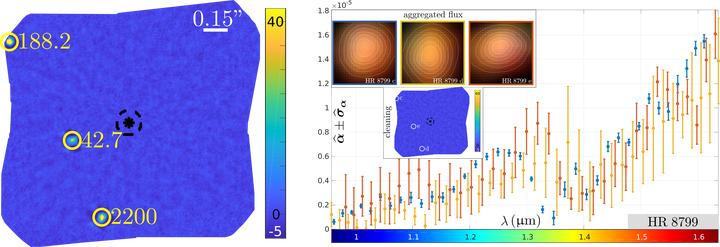PACO ASDI: an algorithm for exoplanet detection and characterization in direct imaging with integral field spectrographs
Astronomy & Astrophysics, vol. 637, A9
 Example of detection map (left) and estimated exoplanet spectra (right) obtained with PACO ASDI.
Example of detection map (left) and estimated exoplanet spectra (right) obtained with PACO ASDI.
Abstract
Context. Exoplanet detection and characterization by direct imaging both rely on sophisticated instruments (adaptive optics and coronagraph) and adequate data processing methods. Angular and spectral differential imaging (ASDI) combines observations at different times and a range of wavelengths in order to separate the residual signal from the host star and the signal of interest corresponding to off-axis sources.
Aims. Very high contrast detection is only possible with an accurate modeling of those two components, in particular of the background due to stellar leakages of the host star masked out by the coronagraph. Beyond the detection of point-like sources in the field of view, it is also essential to characterize the detection in terms of statistical significance and astrometry and to estimate the source spectrum.
Methods. We extend our recent method PACO, based on local learning of patch covariances, in order to capture the spectral and temporal fluctuations of background structures. From this statistical modeling, we build a detection algorithm and a spectrum estimation method: PACO ASDI. The modeling of spectral correlations proves useful both in reducing detection artifacts and obtaining accurate statistical guarantees (detection thresholds and photometry confidence intervals).
Results. An analysis of several ASDI datasets from the VLT/SPHERE-IFS instrument shows that PACO ASDI produces very clean detection maps, for which setting a detection threshold is statistically reliable. Compared to other algorithms used routinely to exploit the scientific results of SPHERE IFS, sensitivity is improved and many false detections can be avoided. Spectrally smoothed spectra are also produced by PACO ASDI. The analysis of datasets with injected fake planets validates the recovered spectra and the computed confidence intervals.
Conclusions. PACO ASDI is a high-contrast processing algorithm accounting for the spatio-spectral correlations of the data to produce statistically-grounded detection maps and reliable spectral estimations. Point source detections, photometric and astrometric characterizations are fully automatized.